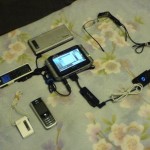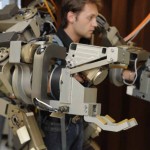Archive for 2009
The Apollo Number: Space Suits, Self-Support, and the Walk-Run Transition
- Тип контента: Научная статья
- Номер документа: 6521
- Название документа: The Apollo Number: Space Suits, Self-Support, and the Walk-Run Transition
- Номер (DOI, IBSN, Патент): Не заполнено
- Изобретатель/автор: Christopher E. Carr, Jeremy McGee
- Правопреемник/учебное заведение: Massachusetts Institute of Technology, Cambridge, Massachusetts, United States of America
- Дата публикации документа: 2009-08-12
- Страна опубликовавшая документ: США
- Язык документа: Английский
- Наименование изделия: Не заполнено
- Источник: PLoS ONE
- Вложения: Да
- Аналитик: Глаголева Елена
 Background: How space suits affect the preferred walk-run transition is an open question with relevance to human biomechanics and planetary extravehicular acti-vity. Walking and running energetics differ; in reduced gravity (,0.5 g), running, unlike on Earth, uses less energy per distance than walking. Methodology/Principal Findings: The walk-run transition (denoted *) correlates with the Froude Number (Fr = v2/gL, velocity v, gravitational acceleration g, leg length L). Hu-man unsuited Fr* is relatively constant (,0.5) with gravity but increases substantially with decreasing gravity below ,0.4 g, rising to 0.9 in 1/6 g; space suits appear to lower Fr*. Because of pressure forces, space suits partially (1 g) or completely (lunar-g) support their own weight. We define the Apollo Number (Ap = Fr/M) as an expected invariant of locomotion under manipulations of M, the ratio of human-supported to total transported mass. We hypothesize that for lunar suited conditions Ap* but not Fr* will be near 0.9, because the Apollo Number captures the effect of space suit self-support. We used the Apollo Lunar Surface Journal and other sources to identify 38 gait events during lunar exploration for which we could determine gait type (walk/lope/run) and calculate Ap. We estimated the binary transition between walk/lope (0) and run (1), yielding Fr* (0.3660.11, mean695% CI) and Ap* (0.6860.20). Conclusions/Significance: The Apollo Number explains 60% of the difference between suited and unsuited Fr*, appears to capture in large part the effects of space suits on the walk-run transition, and provides several testable predictions for space suit locomotion and, of increasing relevance here on Earth, exoskeleton locomotion. The knowledge of how space suits affect gait transitions can be used to optimize space suits for use on the Moon and Mars.
Background: How space suits affect the preferred walk-run transition is an open question with relevance to human biomechanics and planetary extravehicular acti-vity. Walking and running energetics differ; in reduced gravity (,0.5 g), running, unlike on Earth, uses less energy per distance than walking. Methodology/Principal Findings: The walk-run transition (denoted *) correlates with the Froude Number (Fr = v2/gL, velocity v, gravitational acceleration g, leg length L). Hu-man unsuited Fr* is relatively constant (,0.5) with gravity but increases substantially with decreasing gravity below ,0.4 g, rising to 0.9 in 1/6 g; space suits appear to lower Fr*. Because of pressure forces, space suits partially (1 g) or completely (lunar-g) support their own weight. We define the Apollo Number (Ap = Fr/M) as an expected invariant of locomotion under manipulations of M, the ratio of human-supported to total transported mass. We hypothesize that for lunar suited conditions Ap* but not Fr* will be near 0.9, because the Apollo Number captures the effect of space suit self-support. We used the Apollo Lunar Surface Journal and other sources to identify 38 gait events during lunar exploration for which we could determine gait type (walk/lope/run) and calculate Ap. We estimated the binary transition between walk/lope (0) and run (1), yielding Fr* (0.3660.11, mean695% CI) and Ap* (0.6860.20). Conclusions/Significance: The Apollo Number explains 60% of the difference between suited and unsuited Fr*, appears to capture in large part the effects of space suits on the walk-run transition, and provides several testable predictions for space suit locomotion and, of increasing relevance here on Earth, exoskeleton locomotion. The knowledge of how space suits affect gait transitions can be used to optimize space suits for use on the Moon and Mars.
Категория: Научные статьи | Нет комментариев »
Passive exoskeleton
- Тип контента: Патент
- Номер документа: 5247
- Название документа: Passive exoskeleton
- Номер (DOI, IBSN, Патент): US007571839B2
- Изобретатель/автор: Chu C., Chu, A.
- Правопреемник/учебное заведение: HRL Laboratories, LLC, Malibu, CA, USA
- Дата публикации документа: 2009-08-11
- Страна опубликовавшая документ: США
- Язык документа: Английский
- Наименование изделия: Не заполнено
- Источник: http://www.google.com/patents/US7571839
- Вложения: Да
- Аналитик: Дмитрий Соловьев
 The present invention relates to a load bearing apparatus, and more particularly, to a passive exoskeleton whereby a load may be placed on the passive exoskeleton and thereby transfer weight of the load from the passive exoskeleton to a ground surface. The passive exoskeleton comprises a rigid body member for attaching proximate a portion of a user’s body, a sliding rod attached with the body member, and a ground surface engage-able foot analog attached with the sliding rod. When a user places a load on the body member, weight of the load from is transferred from the body member, through the sliding rod, and into the foot analog, causing the passive exoskeleton to support at least a portion of the load.
The present invention relates to a load bearing apparatus, and more particularly, to a passive exoskeleton whereby a load may be placed on the passive exoskeleton and thereby transfer weight of the load from the passive exoskeleton to a ground surface. The passive exoskeleton comprises a rigid body member for attaching proximate a portion of a user’s body, a sliding rod attached with the body member, and a ground surface engage-able foot analog attached with the sliding rod. When a user places a load on the body member, weight of the load from is transferred from the body member, through the sliding rod, and into the foot analog, causing the passive exoskeleton to support at least a portion of the load.
Категория: Патенты | Нет комментариев »
A lower limb EMG-driven biomechanical model for applications in rehabilitation robotics
- Тип контента: Научная статья
- Номер документа: 1395
- Название документа: A lower limb EMG-driven biomechanical model for applications in rehabilitation robotics
- Номер (DOI, IBSN, Патент): Не заполнено
- Изобретатель/автор: Sartori, M., Reggiani, M., Pagello, E., Mezzato, C.
- Правопреемник/учебное заведение: Dept. of Inf. Eng., Univ. of Padova, Padova, Italy
- Дата публикации документа: 2009-07-28
- Страна опубликовавшая документ: Италия
- Язык документа: Английский
- Наименование изделия: Не заполнено
- Источник: http://ieeexplore.ieee.org/search/freesrchabstract.jsp?tp=&a
- Вложения: Да
- Аналитик: Дмитрий Соловьев
 Current changes in aging demographics poses new challenges: people require to keep their quality of life even after circumstances that threatened their movement and function. This increases the demand for new physical rehabilitation facilities that go beyond the traditional patient-therapist, one-to-one rehabilitation sessions. Two promising solutions rely on virtual reality and on the development of autonomous active orthoses, or exoskeletons. Whatever is the chosen approach, there is a requirement for a robust human-machine interface for the control, able to understand patient’s intention and to produce an immediate activation of the device. This paper presents a biomechanical model, a possible solution able to predict joint torque from the surface electromyography signals emitted by muscles during their activation. The main objective of the research is to investigate the benefits and efficacy of this model and to lay down the basis of our current research, whose main goal is to make possible a rehabilitation process either with active orthoses or virtual reality. Experiments involving all the steps of our model demonstrate the viability and effectiveness of our approach.
Current changes in aging demographics poses new challenges: people require to keep their quality of life even after circumstances that threatened their movement and function. This increases the demand for new physical rehabilitation facilities that go beyond the traditional patient-therapist, one-to-one rehabilitation sessions. Two promising solutions rely on virtual reality and on the development of autonomous active orthoses, or exoskeletons. Whatever is the chosen approach, there is a requirement for a robust human-machine interface for the control, able to understand patient’s intention and to produce an immediate activation of the device. This paper presents a biomechanical model, a possible solution able to predict joint torque from the surface electromyography signals emitted by muscles during their activation. The main objective of the research is to investigate the benefits and efficacy of this model and to lay down the basis of our current research, whose main goal is to make possible a rehabilitation process either with active orthoses or virtual reality. Experiments involving all the steps of our model demonstrate the viability and effectiveness of our approach.
Категория: Научные статьи | Нет комментариев »
Носимый компьютер — еще один этап «киборгизации».
- Тип контента: Новостная статья
- Номер документа: 4706
- Название документа: Носимый компьютер - еще один этап "киборгизации"
- Номер (DOI, IBSN, Патент): Не заполнено
- Изобретатель/автор: Не заполнено
- Правопреемник/учебное заведение: Не заполнено
- Дата публикации документа: 2009-07-28
- Страна опубликовавшая документ: Россия
- Язык документа: Русский
- Наименование изделия: Не заполнено
- Источник: http://www.3dnews.ru/news/nosimii_komputer_eshe_odin_etap_ki
- Вложения: Не заполнено
- Аналитик: Helix
 «Киборгизация» человека идет медленным, но верным путем. Регулярно совершенствующиеся искусственные конечности, имплантируемые под кожу чипы идентификации, бионические глаза, экзоскелеты, позволяющие поднять на порядок больший вес… Сейчас это всего лишь концепции или работающие прототипы с ограниченным функционалом.
«Киборгизация» человека идет медленным, но верным путем. Регулярно совершенствующиеся искусственные конечности, имплантируемые под кожу чипы идентификации, бионические глаза, экзоскелеты, позволяющие поднять на порядок больший вес… Сейчас это всего лишь концепции или работающие прототипы с ограниченным функционалом.
Категория: Амуниция | Нет комментариев »
Body Extender.Невероятный Халк существует и живет в Pontedera.
- Тип контента: Новостная статья
- Номер документа: 3206
- Название документа: Body Extender.Невероятный Халк существует и живет в Pontedera.
- Номер (DOI, IBSN, Патент): Не заполнено
- Изобретатель/автор: Не заполнено
- Правопреемник/учебное заведение: Не заполнено
- Дата публикации документа: 2009-07-24
- Страна опубликовавшая документ: Италия
- Язык документа: Русский
- Наименование изделия: Body Extender
- Источник: http://mmedia.kataweb.it/foto/6998774/1/l-incredibile-hulk-e
- Вложения: Не заполнено
- Аналитик: Не заполнено
 Невероятный Халк существует и находится в центре робототехники лаборатории Percro, Pontedera,школы Sant’Anna в Пизе. Это экзоскелет «Body Extender», усилитель и мультипликатор сила человека.Этот экзоскелет позволяет увеличить силу человека в десять раз. Проект, получивший название «Рубашка Халка», был создан по заказу Министерства обороны Италии.
Невероятный Халк существует и находится в центре робототехники лаборатории Percro, Pontedera,школы Sant’Anna в Пизе. Это экзоскелет «Body Extender», усилитель и мультипликатор сила человека.Этот экзоскелет позволяет увеличить силу человека в десять раз. Проект, получивший название «Рубашка Халка», был создан по заказу Министерства обороны Италии.
Категория: Body Extender | Нет комментариев »
Статистика
Категорий: 179
Статей всего: 2,003
По типу:
Видео: 36
Выдержка с форума: 1
Контактные данные: 12
Научная статья: 1388
Не заполнено: 5
Новостная статья: 317
Обзор технологии: 42
Патент: 219
Тех.подробности: 34
Тип: 1
Комментариев: 8,689
Изображений: 3,005
Подробней...
ТОР 10 аналитиков
-
Глаголева Елена - 591
Дмитрий Соловьев - 459
Helix - 218
Ридна Украина))) - 85
Наталья Черкасова - 81
max-orduan - 29
Елена Токай - 15
Роман Михайлов - 9
Мансур Жигануров - 4
Дуванова Татьяна - 3
Календарь
| Пн | Вт | Ср | Чт | Пт | Сб | Вс |
|---|---|---|---|---|---|---|
| « Ноя | ||||||
| 1 | 2 | 3 | 4 | 5 | ||
| 6 | 7 | 8 | 9 | 10 | 11 | 12 |
| 13 | 14 | 15 | 16 | 17 | 18 | 19 |
| 20 | 21 | 22 | 23 | 24 | 25 | 26 |
| 27 | 28 | 29 | 30 | 31 | ||
Авторизация
Ошибка в тексте?
Выдели её мышкой!
И нажми Ctrl+Enter